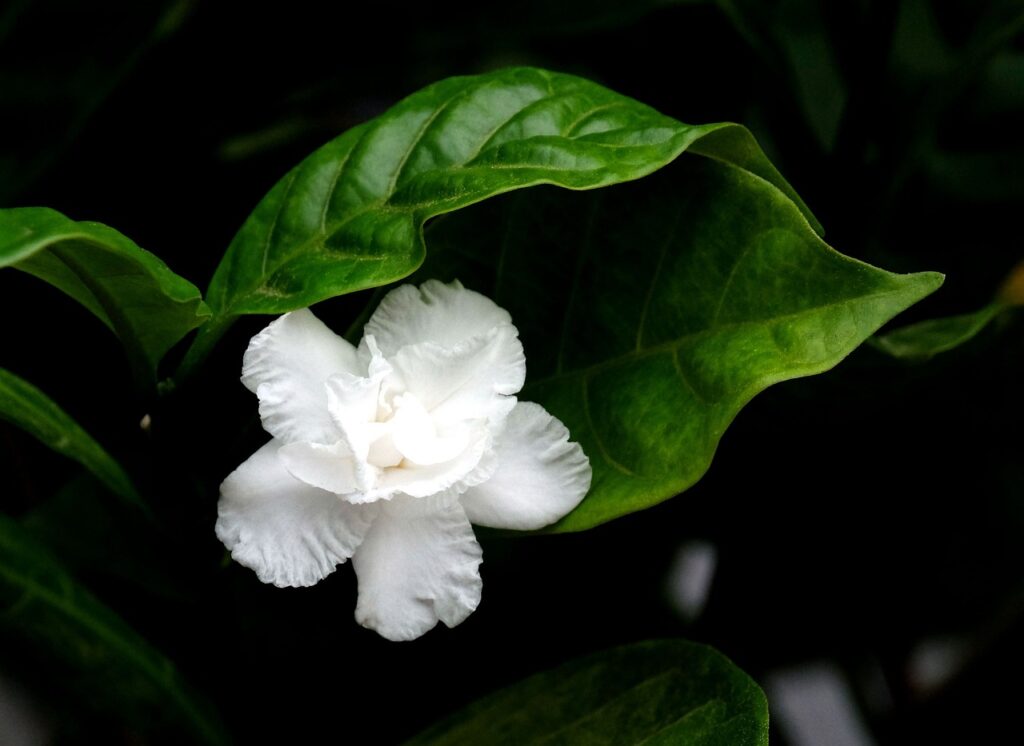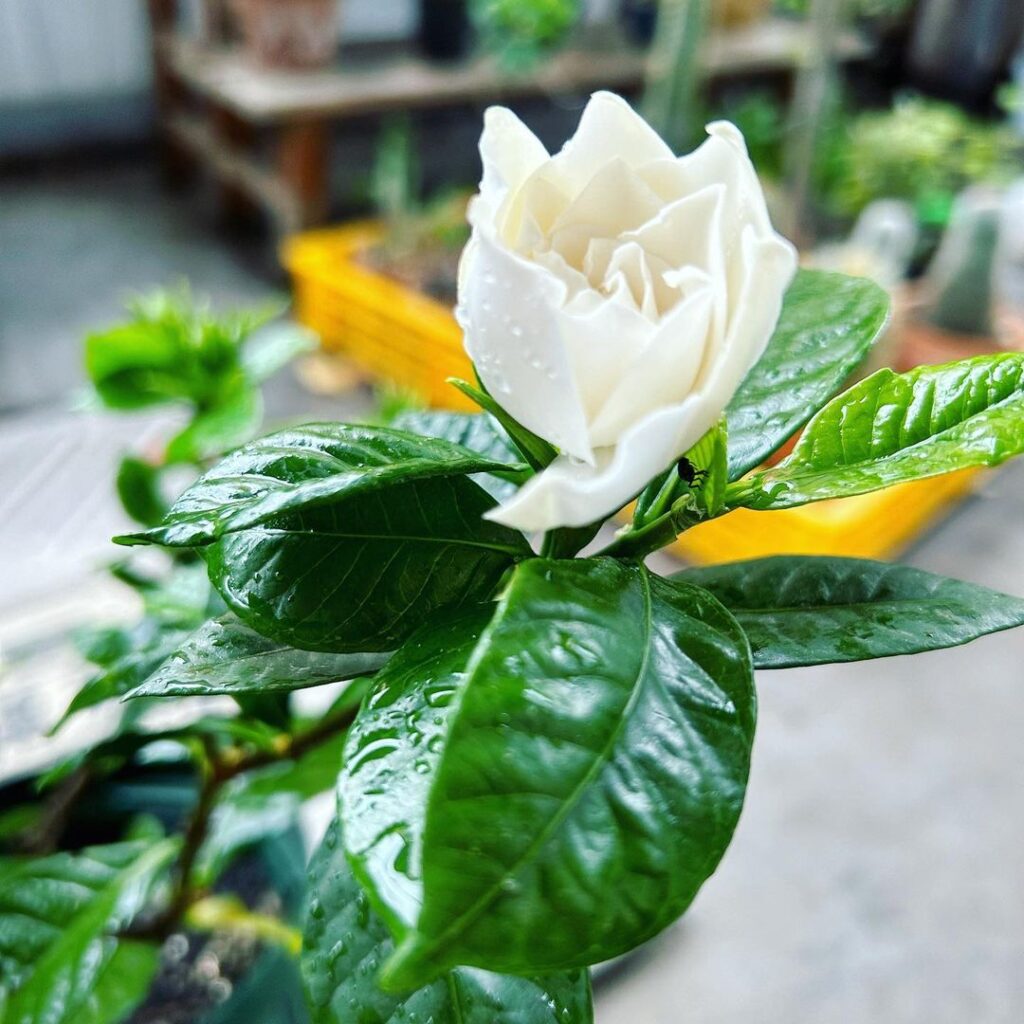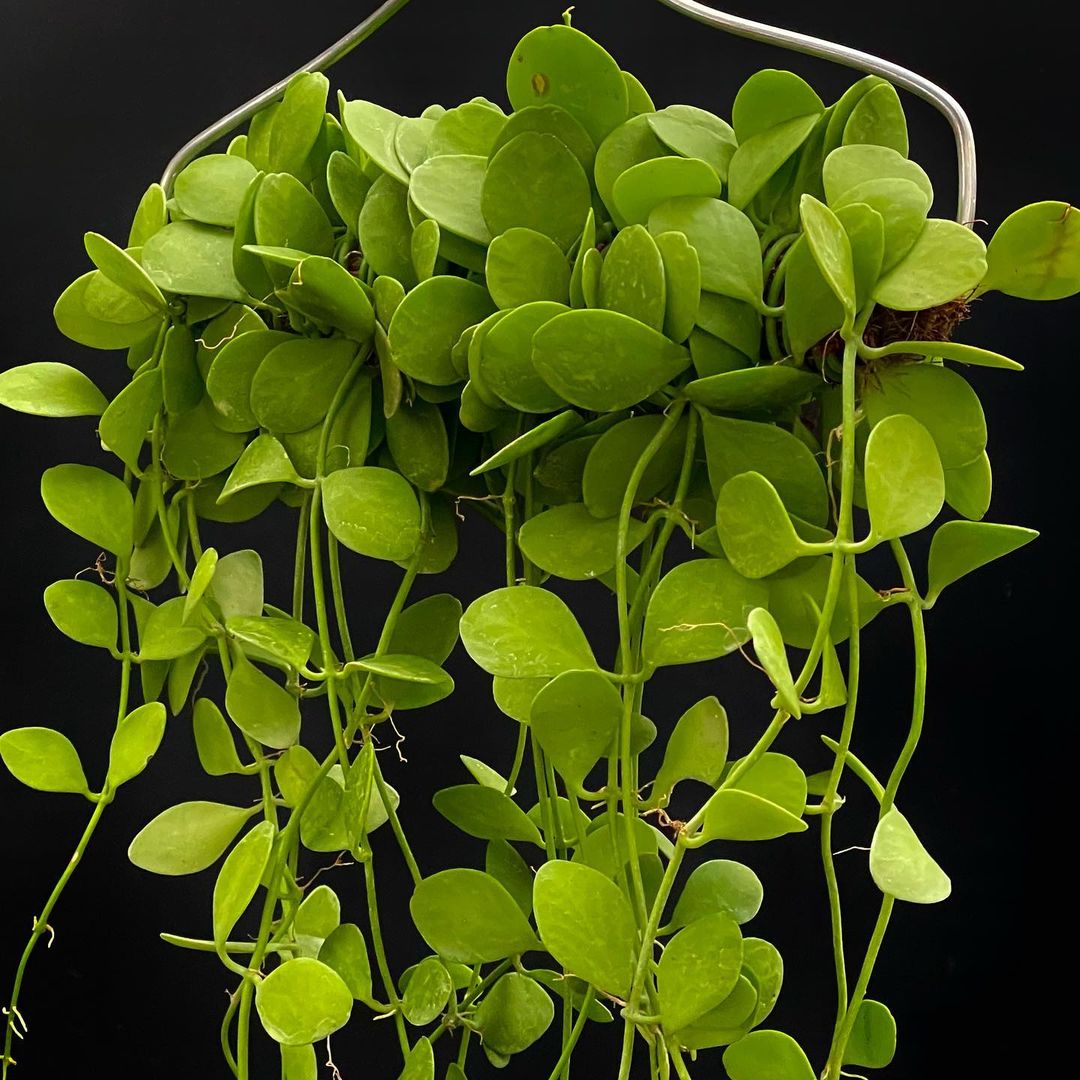The smell of Gardenia flowers is famous for its ability to bring out strong feelings and make a lasting impact.
Gardenia Growing and Care in Pots is not difficult. If you want to grow these pretty blooms in a limited space, this guide will provide you with essential tips to grow gardenia successfully.
Common Name: Gardenia, cape jasmine, danh-danh, gandhraj, jasmine rose, rose jasmine
Botanical Name: Gardenia jasminoides
USDA Zones: 8-11
Gardenia Plant Information

Gardenia (Gardenia jasminoides) is a beautiful tropical shrub with broad, evergreen leaves. It is commonly grown as a sizeable indoor houseplant, mainly for its exquisite fragrance that comes from its blooms.
It’s a difficult plant to care for and is usually only found in special indoor gardens and professional greenhouses. But if you’re willing to put in the effort, even a few months of flowers can make it rewarding.
You can also plant gardenias outside in the spring or fall in the southern United States or along the Pacific Coast. You can buy mature potted gardenia plants so that they can bloom right away. If you decide to grow gardenias from seeds, be prepared to wait two to three years before the plant starts flowering.
Growing Gardenia in Pots

It is indeed possible to grow gardenias in pots, which is particularly beneficial if you have limited space or reside in a cool, temperate climate. Gardenias can thrive quite well in USDA Zones 8 to 11. However, if you live in zones below this range, you have the option of growing them as houseplants or keeping them indoors during the winter months.
Note: While keeping gardenia indoors, locate them in the sunniest spot. Gardenias have a higher sunlight requirement. In the absence of adequate light, they are prone to attracting insects.
Propagating Gardenia

How to Grow Gardenia From Seed
If you decide to grow gardenias from seeds, be prepared to wait two to three years before the plant starts flowering.
- First, collect and clean the seeds from dried seed pods. Then, let them dry in a sunny window for three to four weeks.
- To plant the gardenia seeds, use a mixture of perlite and peat moss.
- Gently cover the seeds with around 1/8 inch of potting mix.
- Keep the seeds moist and away from direct sunlight until they start sprouting, which usually takes about four to six weeks.
- Once the seedlings grow a few inches tall, transfer them to pots filled with potting soil that has peat.
- Continue growing them in a sunny spot indoors.
- When the seedlings have grown three sets of leaves, you can move them to your garden.
- Take care of the young plants and keep looking after them until they grow.
Propagate from Stem Cuttings
The best way to grow gardenia plants is by stem cuttings and rooting them in the early spring. However, many gardeners find it easier to propagate gardenias from cuttings taken while pruning. Whichever method you prefer, make sure to give the new plant enough time to develop roots and grow before the winter dormancy period.
- Use garden shears to take a 3- to 5-inch cutting from a stem tip, preferably from green wood just below a leaf node.
- Remove the lower leaves, leaving only the top set of two leaves.
- Prepare pots with moist potting soil and create a hole in the center of the soil.
- Dip the cut end of the stem into the rooting hormone and then place the stem into the hole. Fill the hole with soil.
- Cover the pots with plastic bags and support them with garden stakes.
- Put the pots in a well-lit area with indirect sunlight. Make sure the room temperature is at least 75°F (24°C).
- Keep the soil moist until roots start to form, which usually takes about four to eight weeks.
- Once the temperatures are suitable, transplant the young gardenias into your garden.
Container Size
Select a pot that is at least 12 inches in diameter and must have drainage holes. You can choose a terra-cotta or plastic container for gardenia.
Types of Gardenias
The gardenia plant has been extensively grown in warm climates as an outdoor plant. A common practice involves creating various varieties through the process of grafting onto a Gardenia thunbergia rootstock. Grafted gardenia plants typically exhibit more vigorous growth and larger blooms. However, it’s important to note that they have an even lower tolerance to cold temperatures compared to non-grafted species.
A few of the best varieties are as follows:
1.Gardenia jasminoides ‘Fortuniana’
Popular as an exceptional free-blooming cultivar, it is a large shrub that delights with its continuous production of 4-inch blooms throughout the entire season.
2. G. jasminoides ‘Buttons’
This dwarf variety reaches up to 24-30 inches tall and produces 2-inch blooms.
3. Gardenia jasminoides ‘Aimee’
It can reach up to 6 feet tall and offer big 4-5 inch wide white blossoms.
4. Gardenia jasminoides ‘Crown Jewel’
With a growth habit forming a compact mound that reaches a height of 3 feet, this particular variety produces beautiful 3-inch flowers. Notably, this plant is recognized for its hardiness, capable of thriving in regions as far north as Zone 6.
Learn How to Grow Moon Lilies
Gardenia Growing and Care in Pots
Location
Indoor potted gardenias thrive in bright light but prefer to avoid direct sunlight, especially in the summer. It is ideal for placing them in a sunny window with afternoon shade.
When planting gardenias in a garden, they do best in a partially shaded location. Providing them with sun and afternoon shade works well in such cases.
Soil
Gardenias prefer acidic soil, which means they thrive in soil with a lower pH. Potting mixes with a peat base typically fulfill this requirement. When planting gardenias outdoors, it is advisable to test the soil’s pH and make necessary amendments. Lowering the soil pH can be facilitated by adding a teaspoon of agricultural sulfur into the planting hole.
Water
Gardenias typically require approximately one inch of water per week, whether from rainfall or manual watering. It is recommended to use drip irrigation for gardenias as it avoids water contact with the leaves, which can lead to fungal leaf spots. During winter, it is advisable to reduce watering and keep the soil slightly moist to the touch. This winter watering approach is also suitable for potted gardenias.
Temperature and Humidity
Gardenias thrive in temperatures above 60°F and should avoid cold drafts. Additionally, they prefer a humidity level of at least 60%. To ensure adequate humidity, indoor gardenias may require the use of a humidifier or regular misting, especially during the cold and dry winter months.
Learn How to Grow Toona Sinensis ‘Flamingo’ Tree
Gardenia Care in Pots
Fertilizer
Apply an acid-rich fertilizer in mid-March and late June. Follow the recommended amounts specified on the product packaging and mix the fertilizer directly into the soil or dilute it with water as instructed. It is advisable to slightly under-dose the fertilizer to prevent over-fertilization. In the fall, discontinue feeding your gardenias to discourage new growth before their dormancy period.
For container gardenias, fertilize them approximately every three weeks using an acidifying fertilizer similar to the ones used for azaleas or camellias. Organic gardeners often opt for a blood meal, fish emulsion, or bone meal as alternative choices. It is important to follow the product recommendations regarding the amounts to use and to test the soil’s pH regularly. This will help ensure optimal nutrient balance for your gardenias.
Pruning
After gardenias have finished blooming, it is advisable to prune them by removing any straggly branches and spent blooms according to your preference. However, it is not necessary to prune gardenias every season. This particular variety can be pruned every other year without any issues. When pruning, utilize sharp garden shears to shape back both the green and brown wood. It’s noteworthy that gardenias can set buds on both new and old wood, so pruning either type is acceptable.
Repotting
Repot gardenias in the spring, as they start emerging from their winter dormancy. Repotting should be considered if the plant appears root-bound, indicated by roots protruding from the soil.
If your gardenia appears less vibrant despite being free from insects or diseases, repotting can also be beneficial. Select a pot that is one size larger and go for a natural stone or terracotta pot. These materials have porous walls that facilitate the evaporation of moisture.
Overwintering
Tropical gardenias cannot tolerate temperatures below 15°F and are particularly vulnerable to winter frost. Although regions within USDA Zones 8 to 10 generally do not encounter such extreme weather conditions, it is still important to take precautions to protect the warmth of your gardenia plant.
To ensure the protection and warmth of your gardenia plant, it is recommended to apply generous mulch around the base of the plant. This helps insulate the roots. Additionally, on nights when there is a risk of frost, you can create a frost blanket. Frost cloth is readily available at nurseries, or you can improvise by using items like a cardboard box, a bedsheet, or a 5-gallon bucket.
Pests and Diseases
Gardenias are often considered high-maintenance due to their susceptibility to various insects, including scales, aphids, spider mites, mealybugs, and whiteflies. To combat these pests, there are several options available, such as horticultural oils, soaps, and organic products. Regardless of the chosen method, it is important to be prepared for frequent infestations and take proactive measures.
They are susceptible to various fungal diseases such as powdery mildew, leaf spot, dieback, anthracnose, and sooty mold. While fungicides can be used to treat some of these issues, in certain cases, affected plants may need to be removed and disposed of.
Toxicity
According to ASPCA (American Society for the Prevention of Cruelty to Animals), Gardenia is toxic to dogs, cats, and horses. So, locate the plant away from pets and kids in your home.
How to Get Gardenia to Bloom
Gardenia flowers bloom from late spring to fall, with each individual bloom remaining vibrant for several weeks before eventually wilting.
- To encourage continuous flower production, it is advisable to deadhead or remove spent blooms after they have withered.
- To optimize the blooming potential of your gardenia, it is crucial to provide it with ideal growing conditions, including proper fertilization and watering practices.
- For pruning, it is advisable to wait until after the last blooms have faded. This timing ensures that you avoid cutting back any new buds that may be forming.
- To prevent “bud drop,” a condition known to affect gardenias, it is essential to maintain optimal humidity and moisture levels. Ensure that the humidity is adequate and the soil is kept consistently moist but not overly dry or waterlogged.



